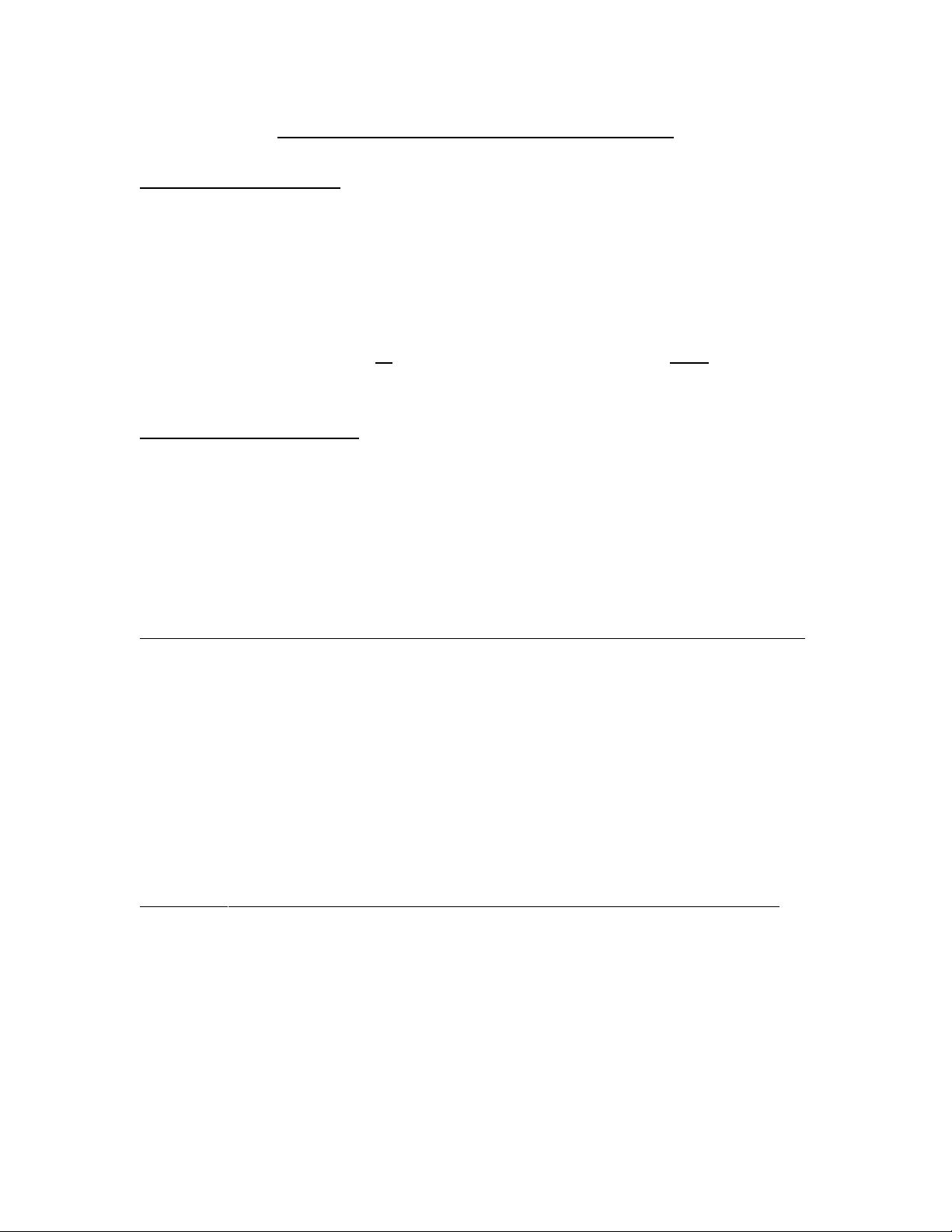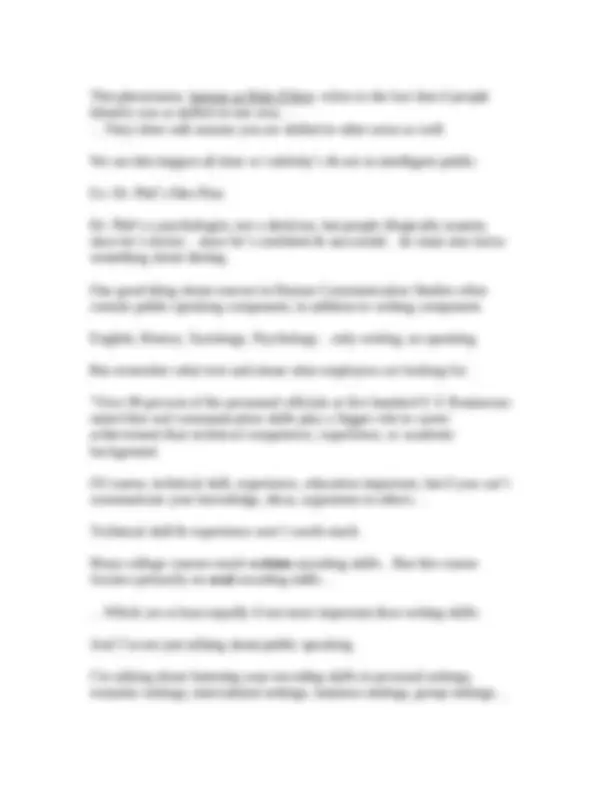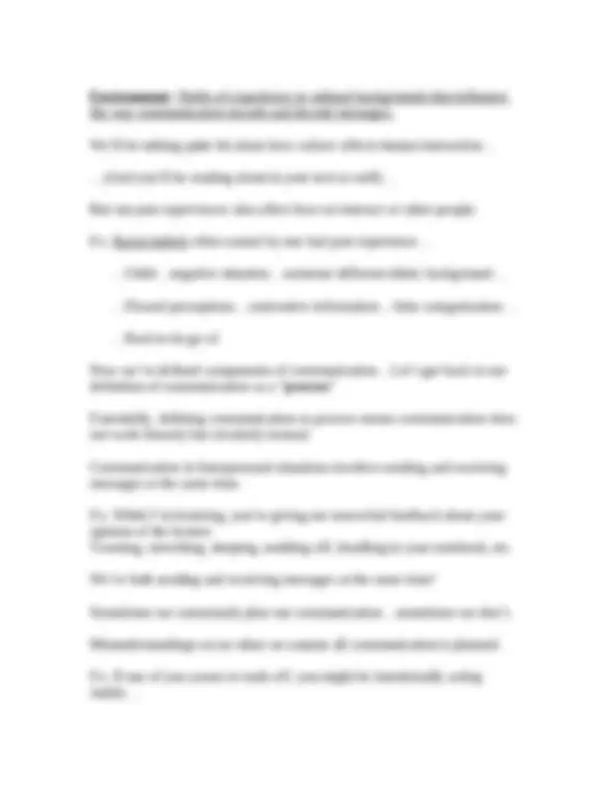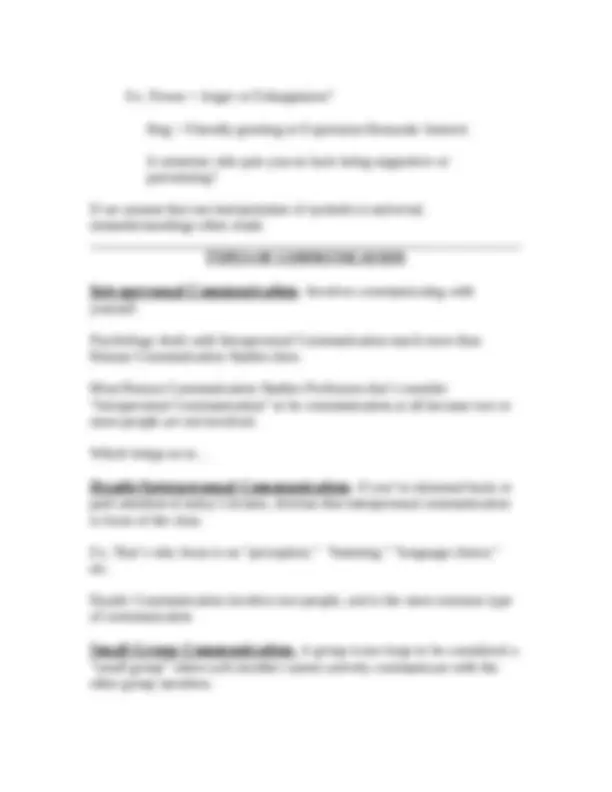








Study with the several resources on Docsity

Earn points by helping other students or get them with a premium plan


Prepare for your exams
Study with the several resources on Docsity

Earn points to download
Earn points by helping other students or get them with a premium plan
Community
Ask the community for help and clear up your study doubts
Discover the best universities in your country according to Docsity users
Free resources
Download our free guides on studying techniques, anxiety management strategies, and thesis advice from Docsity tutors
The concept of communication as a process, focusing on the components of communication, including senders, receivers, encoding, decoding, and various types of noise. It emphasizes the importance of oral encoding skills and the impact of communication on career achievement. The document also discusses the challenges of decoding messages effectively due to external, physiological, and psychological noise.
Typology: Study notes
1 / 12

This page cannot be seen from the preview
Don't miss anything!







COMMUNICATION - The process of human beings responding to the symbolic behavior of other persons. -First Characteristic of Definition: Communication is a “Process.” Communication is “Process” several reasons:
1. We do not communicate to other people, we communicate with other people. To understand difference, we first need to talk about the components of communication: -Sender, Receiver… -Message Encoding, Message Decoding… -Psychological Noise, Physiological Noise -Communication Channels, -AND Communication Environment. Sender- The person or persons responsible for creating a message to be sent. Ex. A politician giving a speech… A parent lecturing a child… A divorced middle age women writing a love letter to her favorite soap opera star… …All these people are sending messages. Receiver- The person or persons who are receiving the created messages. Ex. An audience receives the politician’s speech… The unfortunate child is the recipient of the parents lecture… The soap opera star is the lucky receiver of our divorcee’s romantic letter.
Communication Channel - The medium a receiver uses to send his or her message. Channels may be verbal or nonverbal Ex. Speech is a channel… Writing is a channel… Non-verbal gestures are channels… Voice Tones are channels…And so on. Encoding - When a sender attempts to replicate his or her internal thoughts or feelings into some kind of external message medium for the sake of transmitting those thoughts or feelings to another person or persons. It’s easy to tell if sender encodes message poorly because he or she say things like: “That’s not what I meant to say,” or… “That’s not what I mean,” or… “What I really wanted to say was…” and so forth. If someone is a skilled “encoder,” we call him or her “articulate,” “well spoken,” or even “eloquent.” And research has shown that good speakers are considered more trustworthy, intelligent, competent, and personable than poor speakers… …even if speaker’s are saying exact same thing. Obviously, there isn’t always a relationship between speaking well & intelligence & competency… Sure some newscasters, actors, & politicians are bright…But many times they aren’t…but we think they are simply because they speak well.
…So public speaking is very small portion of this class. Message Decoding - Occurs when the receiver attempts to ascertain the meaning of the sender’s message. And figuring out what other people “mean” isn’t easy. I’m sure all of us had times when we’ve had others become frustrated w/ us because we didn’t understand what they meant… I’m sure we’ve all became frustrated w/ other people when they didn’t understand what we meant. **There are several factors that prevent human beings from decoding other’s messages effectively… Noise - Any force that interferes with effective communication. Three types: External noise, physiological noise, psychological noise. External Noise - Refers to any physical phenomenon that might impair a receiver’s ability to decode a message. Ex. Gym, Elevator Music Blaring… Bodybuilders grunting… Treadmills running… She was paying attention, just couldn’t hear my name…that why call me “Phil,” not “Paul.” Physiological Noise - Involves biological factors in the receiver or sender that interfere with accurate reception. Ex. Seinfeld: George’s “I love You” Psychological Noise- Involves mental forces within a receiver or sender that might inhibit his or her ability to either encode or decode a message correctly. Ex. If a receiver suffers from low-self esteem, might interpret a sincere compliment as sarcastic or condescending even though it wasn’t.
Environment - Fields of experience or cultural backgrounds that influence the way communicators encode and decode messages. We’ll be talking quite bit about how culture affects human interaction… …(And you’ll be reading about in your text as well)… But our past experiences also affect how we interact w/ other people. Ex. Racist beliefs often caused by one bad past experience… …Child…negative situation…someone different ethnic background… …Flawed perceptions…contrastive information…false categorization… …Hard to let go of. Now we’ve defined components of communication…Let’s get back to our definition of communication as a “ process ” Essentially, defining communication as process means communication does not work linearly but circularly instead. Communication in Interpersonal situations involves sending and receiving messages at the same time. Ex. While I’m lecturing, you’re giving me nonverbal feedback about your opinion of the lecture: Yawning, stretching, sleeping, nodding off, doodling in your notebook, etc. We’re both sending and receiving messages at the same time! Sometimes we consciously plan our communication…sometimes we don’t. Misunderstandings occur when we assume all communication is planned. Ex. If one of you yawns or nods off, you might be intentionally acting rudely…
Third, COMMUNICATION is “Symbolic.” Symbols - Are things used to stand for or represent something else. Symbols not limited to words; symbols include nonverbal displays or objects. Ex. “Red light” symbolizes an order to “Stop.” Colors “red, white, and blue” symbolize patriotism. Wearing “Oakland Raiders Gear” symbolizes you can’t read and probably abuse drugs… *So symbols are anything that stands for something else. Also, symbols are arbitrarily developed objects. They have meaning only because certain people agree that they mean the same thing. Obviously, across cultures, symbols are rarely the same. Ex. United States traffic signs for “Yield,” “Merging Lanes,” “Pedestrian Crossing” may or not be the same in other countries And even people in same culture attribute different meaning to same symbols. Ex. (ask two people) If someone or something is Old Fashioned , … what does that mean? Can mean: “Traditional,” “Victorian,” “Time-honored,” “Quaint.” Can mean: “Obsolete,” “Archaic,” “Out-of-Date.” And as book points out, symbolic non-verbal activity can have different meanings for different people:
Ex. Frown = Anger or Unhappiness? Hug = Friendly greeting or Expression Romantic Interest Is someone who pats you on back being supportive or patronizing? If we assume that our interpretation of symbols is universal, misunderstandings often result. TYPES OF COMMUNICATION
yourself. Psychology deals with Intrapersonal Communication much more than Human Communication Studies does. Most Human Communication Studies Professors don’t consider “Intrapersonal Communication” to be communication at all because two or more people are not involved. Which brings us to…
paid attention to today’s lecture, obvious that interpersonal communication is focus of the class. Ex. That’s why focus is on “perception,” “listening,” “language choice,” etc. Dyadic Communication involves two people, and is the most common type of communication
“small group” when each member cannot actively communicate with the other group members.
This may make you appear confident (“maybe he knows something we don’t”), and cause a person or two to jump to your side. Research has shown that once one person changes sides, more may follow. This is known as “Mutiny” in political terms, right? This is why dictators so concerned with anyone who disagrees with them. I should also point out that people in groups have been known to take risks they wouldn’t when alone or in a dyad. Why? Social Proof + Deindividuation. Social Proof- The “Everybody’s Doing It” rationale. Humans model their behavior after other human beings. This is why 99% of Girls in Southern California have tattoos on their lower backs. Monkey see, Monkey do. Another Example of Social Proof: Ford has identified and recruited certain high profile “Soccer Moms” to drive their mini-vans for free. Other mom’s see these “perfect mothers” driving Ford Windstars & want to buy them. Deindividuation- “Getting lost in the crowd.” Because being in a large crowd makes people both AROUSED and ANONYMOUS, they often do things they wouldn’t normally do. Ex. Riot. First , people in riot are aroused. They’re drunk, reacting to some event like their team’s championship or court verdict.
Second , people are anonymous… They feel like they can’t be caught because there are so many people involved. Third difference between groups & dyads is that while dyads can have “leader,” groups ALWAYS have leader, and obviously character of leader shapes character of group.
members to contribute. Characteristics:
ANY immediate audience feedback, verbal or nonverbal. Ex. Movies, TV Shows, Magazines, Newspapers, Radio Broadcasts. Mass Communication of “Mediated Communication” differs from the other forms of communication in several ways: